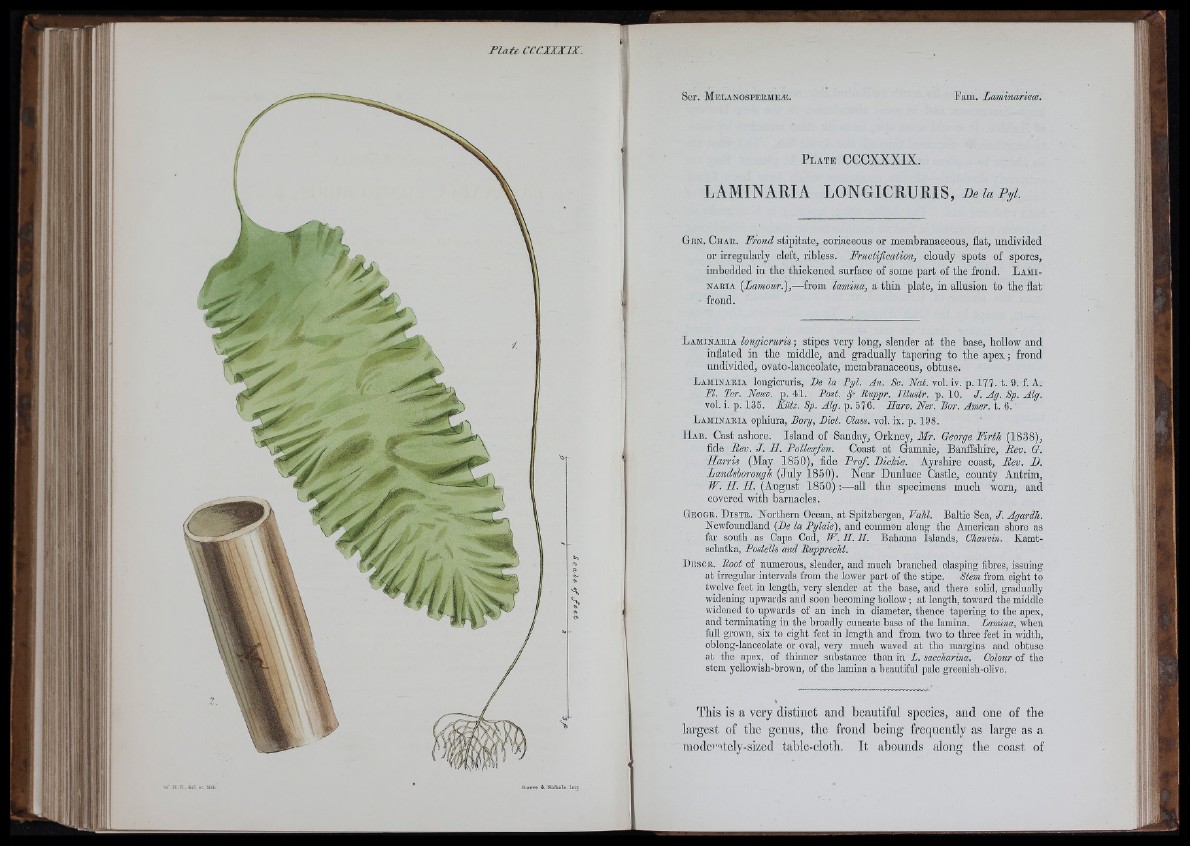
V
W. il .H . t i i l e t lich-. R-eive & TìiclisU. •
P l a t e CCCXXXIX.
LAMINARIA LONGICRLRIS, De la Pyl.
G e n . Ch a e . Frond s tip ita te , coriaceous o r membranaceous, flat, u n d iv id ed
o r irreg u la rly cleft, ribless. Fructification, cloudy spots of spores,
im b ed d ed in th e th ic k e n ed surface o f some p a r t of th e fro n d . L ami-
NAEIA [Lamour.],— from lamina, a th in p la te , in allusion to th e flat
■ fro n d .
L a m in a r ia longicruris ; stipes very long, slender at the base, hollow and
inflated in the middle, and gradually tapering to the apex; frond
undivided, ovato-lanceolate, membranaceous, obtuse.
L aminaria longicruris, De la Pyl. An. Sc. Nat. vol. iv. p. 177. t. 9. f. A.
FI. Ter. Neuv. p. 41. Post. Sp Ruppr. Illustr. p. 10. / . Ag. Sp. Alg.
vol. i. p. 135. Kiitz. Sp. Alg. p. 576. Earv. Ner. Bor. Amer. t. 6.
L aminabia opliiura, Bory, Diet. Glass, vol. ix. p. 198.
H a b . Cast ashore. Island of Sunday, Orkney, Mr. George F irth (1838),
fide lie v . J. I i . Follexfen. Coast at Gamnie, Banffshire, Bev. G.
Harris (May 1850), fide Prof. Bichie. Ayrshire coast, Bev. B .
Landsborough (July 1850). Near Dunluce Castle, county Antrim,
W. II. I I. (August 1850) ;—all the specimens much worn, and
covered with barnacles.
Gbogr. D is t r . Northern Ocean, at Spitzbergen, VaM. Baltic Sea, J . . ^
Newfoundland [De la Pylaie), and common along the American shore as
far south as Cape Cod, W. II. II. Bahama Islands, Chauvin. Kamtschatka,
Pastells and Rupprecht.
Desc r. Root of numerous, slender, and much branched clasping fibres, issuing
at irregular intervals from the lower part of the stipe. Stem from eight to
twelve feet in length, very slender at the base, and there solid, gradually
widening upwards and soon becoming hollow ; at length, toward the middle
widened to upwards of an incli in diameter, thence tapering to the apex,
and terminating in the broadly cuneate base of the lamina. Lamina, when
full grown, six to eight feet in length and from two to three feet in width,
oblong-lanceolate or oval, very much waved at the margins and obtuse
at the apex, of thinner substance than in A. saccharina. Colour of the
stem yellowish-brown, of the lamina a beautiful pale greenish-olive.
This is a very distinct and beautiful species, and one of the
largest of tbe genus, the frond being frequently as large as a
modcr''tely-sized tablc-clotb. It abounds along the coast of